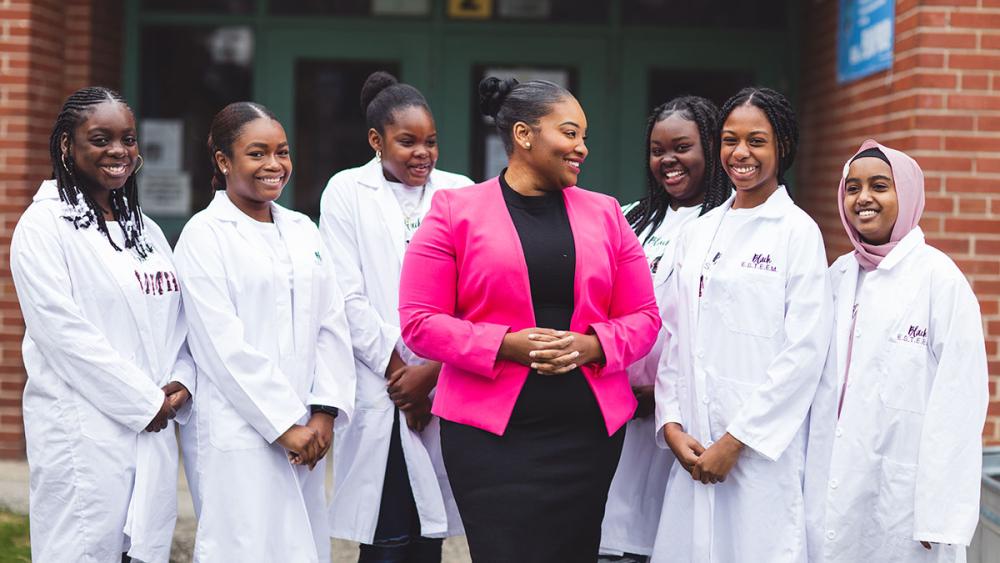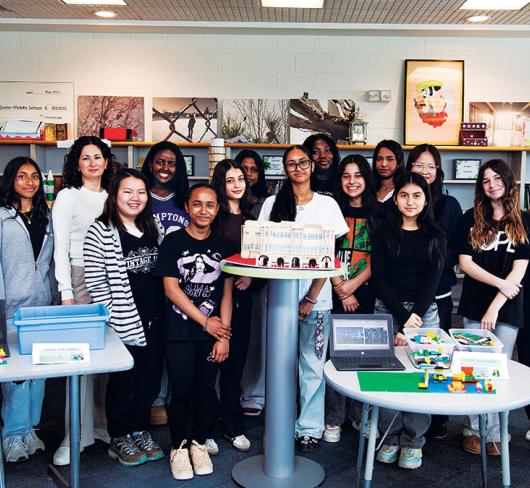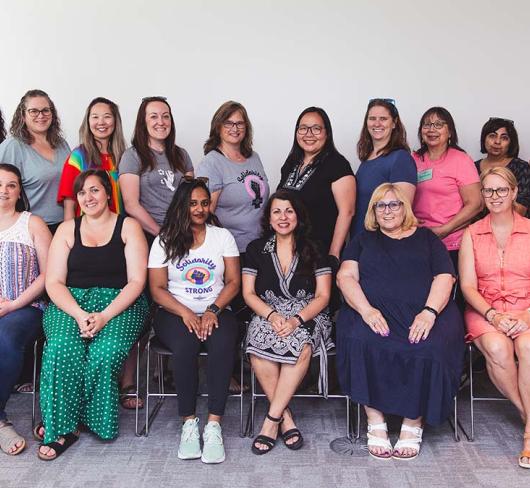
Photo by Christine Cousins
Cultivating Black Girls' E.S.T.E.E.M.
STEPHANIE FEARON: Shayle, I’m so excited to have this conversation with you about the STEM program you created for Black girls. How did your childhood experiences, your family history, your communities and what you saw in your classrooms inform your ideas about what it means to be a teacher activist?
SHAYLE GRAHAM: My communities help shape who I am and inform my ideas about what it means to be a teacher activist. I am a Canadian of Jamaican Maroon ancestry. From Jamaica’s interior mountaintops, my people have spent centuries affirming our self-determination and reimagining our liberated futures. I am also a part of Toronto’s large Afro-Jamaican community where our language, creativity, food and just overall culture continue to leave a mark on this city. I grew up as a Black girl in a cooperative complex in the northwestern part of Toronto. Many outsiders held deficit views about the place I called home. Growing up in the Jane-Finch community, my neighborhood was described as ghetto and dangerous. Children and youth were portrayed as gang members and high school dropouts. The media further stigmatized my neighborhood by depicting it as an unsafe place riddled with gun violence.
Despite these layered and negative narratives, when I think about my experiences growing up as a Black girl, I feel privileged. I was surrounded by educators, family, friends and elders who showered me with love, uplifted my spirit and nurtured my intelligence. In my elementary years, teachers like Ms. Juliet Morales, Ms. Carla Sanchez and Ms. Myrna Gabbidon were constantly telling me that I was fantastic and talented. They reminded me it was beautiful to be a Black girl in Canada, not just in the classroom. These schooling experiences convinced me that the role of educator included ensuring the well-being of students both at school and in the larger community. My family, especially my mother who is affectionately known as Ms. Bev, also helped cultivate my activism. Whether I was pushing back against the deficit views held by some educators or asserting my right to wear a particular hairstyle at six years old, my mother allowed me to express myself and encouraged me to stand up for my community. Mama, my maternal grandmother, would tell stories of triumph and joy to stress the importance of communities coming together to create better futures. I still seek guidance from my 89-year-old Mama.
All these experiences helped me understand teacher activism as the work teachers do to challenge oppressive structures in schools and in communities. For me, teacher activism acknowledges that to truly foster student well-being and academic success means that my work isn’t limited to the classroom – it requires that I identify and address oppression in the school and beyond. Just like the many teacher activists from my childhood, I honour the longstanding leadership, struggles, pride and experiences of the communities I serve. In my current role as a Kindergarten to Grade 12 Learning Coach at the Toronto District School Board, I work with teachers to confront dominant ideologies and practices that harm Black students, families and their communities. I am especially passionate about centring Black girls in STEM experiences both within the classroom and in the larger community.
SF: Why is it important to cultivate affirming STEM spaces for Black girls beyond the classroom? How do you centre Black girl joy and genius in your community activism?
SG: My commitment to Black girlhood and STEM is personal. Although my elementary and middle school teachers helped me identify positively with my racial identity, I wasn’t necessarily celebrated in other academic spaces. I remember struggling in my Grade 10 mathematics class. Right before final exams, my teacher said to me, “Promise me you will never take academic math ever again.” That was my teacher’s advice. I want to make sure that any Black girl I’m connected to never has that experience. Unfortunately, when I became a teacher, I noticed that Black girls continued to have a negative self-perception in relation to STEM.
Once, I asked my Grade 3 students to share their thoughts about mathematics. The students, especially the Black girls, had such negative things to say about math. They made statements like “I’m not good at math,” “I’m scared of math” and “math makes me nervous.” Out of curiosity, I asked the students to think about the characteristics of a mathematician. The young Black girls in the classroom described mathematicians as smart white men with gray beards and glasses. I realized that something had to change with the way that Black girls thought about themselves and their relationship with STEM. The next day, with support from my principal Mr. Ainsworth Morgan, I put up a mirror in my classroom with the statements, “This is what a mathematician looks like” and “This is what a scientist looks like.” Every time students felt insecure about their mathematics or science abilities, I would have them look in the mirror and affirm themselves. This changed the game in terms of how I programmed and engaged students in mathematics and science.
I vowed to create STEM spaces beyond the classroom where Black girls, especially those labeled difficult, could tap into and cultivate their joy and genius. I am especially dedicated to centring Black girls as entrepreneurs, innovators and change makers in STEM fields. Black women thinkers like Drs. Gholdy Muhammad and Cynthia B. Dillard helped me appreciate Black joy as a vehicle to disrupt deficit thinking about Black girls and cultivate their genius. This led me to found a nonprofit organization called Black E.S.T.E.E.M where I serve as the president. E.S.T.E.E.M. is an acronym that stands for entrepreneurs, scientists, technicians, engineers, economists and mathematicians. Our mission is to remove barriers and provide Black girls across Ontario with culturally relevant and responsive opportunities in STEM industries. We partner with institutions like York University’s Lassonde School of Engineering and TD Bank’s Readiness Commitment initiative to engage Black girls in E.S.T.E.E.M. fields like computer science and robotics as well as entrepreneurial academies. For example, at Black E.S.T.E.E.M., Black girls build their chemistry skills by creating skincare and haircare products. Black girls also use engineering and mathematical concepts to better understand the structure of Black hair and popular Black hairstyles.
SF: How do the girls participating in your program exercise their agency and leadership in the work you lead?
SG: Black E.S.T.E.E.M. is actually overseen by a youth advisory group called Black Royalty. Black Royalty tells us what programming they think we should implement and the type of facilitators we need to have on board. The group also advises us on how we should spend grant money. They’ve been such a blessing to our organization because who better to advise us than Black girls themselves.
Black Royalty also engages in mentorship. It’s twofold. They are mentored by the directors of the organization. But they’re also mentoring participants with the aim that these young Black girls will become future members of Black Royalty. We also provide Black Royalty members with the tools they need to effectively advocate for their needs and the needs of their community. This includes everything from software to digital tools and communication training. Black Royalty ensures that Black girls remain powerful leaders within the organization over time.
SF: Your community work involves extensive organizing for Black girls. As a teacher activist, how do you establish an ecosystem around Black girls’ creativity and innovation in STEM?
SG: My work in the community is a heavy lift. Black E.S.T.E.E.M. is more than a not-for-profit organization; it acts as an ecosystem for participants. Black girls in STEM need to be connected to committed stakeholders. I can’t shift systems alone. A diverse group of stakeholders makes up our ecosystem. We all come together to affirm Black girls as STEM leaders. Black E.S.T.E.E.M. is made up of four women directors. Our directors volunteer their time and represent a wide range of industries. Our directors – fellow ETFO member Shannon Adams, human resources coordinator Alicia Pitt and social worker Annette Grossi – help ensure that participating girls have access to and are supported in STEM industries and programming.
Black Royalty plays an important role in centring Black girls’ creativity and innovation in STEM. We also have our participants and their mothers who provide us with feedback help determine the content and structure for upcoming programs and promote Black E.S.T.E.E.M. in their hometowns across the province. Community partners like researchers, community educators, academic and financial institutions and other nonprofit organizations also make up this ecosystem. The passion, expertise and dedication of stakeholders are necessary to usher in the structural changes needed to improve the outcomes and experiences of Black girls in STEM fields.
SF: How can educators support Black girls to be changemakers?
SG: The first thing you can do is get to authentically know the Black girls in the learning space. For example, with my students, I’ve learned where they do their hair, who takes care of them, where they shop and their favourite extracurricular activities. I also make a point to learn about community organizations that support their learning and to form relationships with their families. I appreciate the diversity of Black identities and put in the time to learn about my students’ heritage and ethnicity. I also care about where my students live, the type of music they like and their hobbies. Ultimately, I get to know them as an entire person.
My relationships with Black girls help me to identify shortcomings in systems both within the school and in the larger community. I create programs that address the injustices and obstacles they face. My programming also connects to Black girls’ interests, curiosities and desires to imagine a better world for themselves and loved ones. These preliminary steps help ensure that Black girls’ leadership and joy grounds the work I do within the classroom and beyond.
SF: How might educators reimagine themselves as teacher activists and extend their classroom work beyond the school and into the community?
SG: Teacher activism is my life’s work. My passion for supporting the learning experiences of Black girls in STEM fields extends beyond the classroom and figures in all aspects of my life. For me, teacher activism connects to the Sankofa principle. Derived from the Akan people of Ghana, Sankofa challenges us to revisit the past in order to build better futures. Accordingly, I advise educators to engage in critical self-reflection. Some initial reflection questions include:
- What are some pivotal life experiences that helped shape who you are and who you want to be?
- How might you draw on these experiences to create a better world for the upcoming generation?
- What issues or injustices are you most passionate about? Which ones impact your students and their families?
- How might you leverage your positional power to address these injustices?
- Who are the community leaders? How might you further support their work?
SF: Thank you for sharing these reflection questions. In addition to engaging in critical self-reflection, what are some resources that can help educators learn more about and take action for Black girls in STEM?
SG: Many resources are dedicated to the experiences of Black girls in STEM. Across the province, there are some fabulous people and organizations engaging Black girls and their communities in STEM education. As an initial step, I encourage ETFO members to connect with the Black girls in their classrooms. The Black girls that you serve are invaluable resources and leaders of their own learning journey – at school and in their larger community.
Here are some resources to help educators think through ways to support black girls in STEM:
blackesteem.org and @blackesteem (Twitter, Instagram and YouTube).
Black E.S.T.E.E.M.’s website and social media accounts offer a wide-range of resources. On their media platforms, Black E.S.T.E.E.M. posts updates, educational content and invitations to special events.
Goffney, Boston, M., & Gutiérrez, R. (2018). Rehumanizing Mathematics for Black, Indigenous, and Latinx Students. National Council of Teachers of Mathematics.
The book, Rehumanizing Mathematics for Black, Indigenous, and Latinx Students, presents a series of storied accounts centring mathematics teaching and learning. Through personal reflections intertwined with current scholarship, classroom teachers, school counsellors and administrators, community educators and education researchers share their efforts to facilitate humane, positive and powerful mathematics experiences for Black, Indigenous and/or Latinx students. Included in the book is a section focused on teaching and learning mathematics in community spaces.
Love, Bettina. (2019). We Want to Do More Than Survive: Abolitionist Teaching and the Pursuit of Educational Freedom. Beacon Press.
In the book We Want to Do More Than Survive, Love shares personal stories, research and historical events to expand readers’ ideas about educational freedom. Accordingly, the author invites educators, parents and community leaders to approach educational reform with imagination, joy, love, and urgency.
Joseph, N.M., Hailu, M.F., & Matthews, J. S. (2019). Normalizing Black Girls’ Humanity in Mathematics Classrooms in Harvard Educational Review, 89(1), 132–155.
The article, Normalizing Black Girls’ Humanity in Mathematics Classrooms, investigates what Black girls (grades 6 and 9) think, need and want from their mathematics experiences. Drawing on classroom observations and semi-structured interviews, the authors offer readers math pedagogies that better attend to the humanity of Black girls.
Stephanie Fearon is a member of the Elementary Teachers of Toronto.

